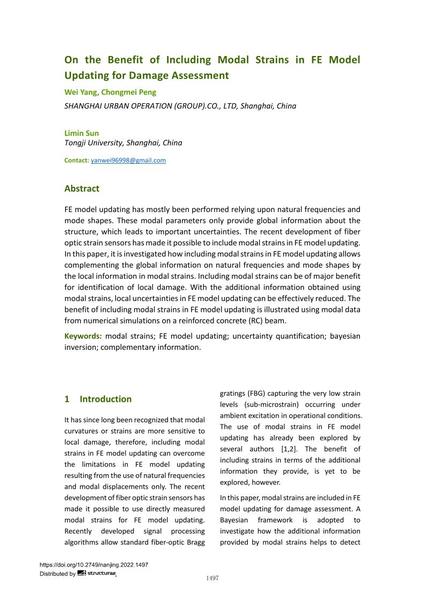On the Benefit of Including Modal Strains in FE Model Updating for Damage Assessment

|
|
|||||||||||
Détails bibliographiques
| Auteur(s): |
Wei Yang
(SHANGHAI URBAN OPERATION (GROUP).CO., LTD, Shanghai, China)
Chongmei Peng (SHANGHAI URBAN OPERATION (GROUP).CO., LTD, Shanghai, China) Limin Sun |
||||
|---|---|---|---|---|---|
| Médium: | papier de conférence | ||||
| Langue(s): | anglais | ||||
| Conférence: | IABSE Congress: Bridges and Structures: Connection, Integration and Harmonisation, Nanjing, People's Republic of China, 21-23 September 2022 | ||||
| Publié dans: | IABSE Congress Nanjing 2022 | ||||
|
|||||
| Page(s): | 1497-1505 | ||||
| Nombre total de pages (du PDF): | 9 | ||||
| DOI: | 10.2749/nanjing.2022.1497 | ||||
| Abstrait: |
FE model updating has mostly been performed relying upon natural frequencies and mode shapes. These modal parameters only provide global information about the structure, which leads to important uncertainties. The recent development of fiber optic strain sensors has made it possible to include modal strains in FE model updating. In this paper, it is investigated how including modal strains in FE model updating allows complementing the global information on natural frequencies and mode shapes by the local information in modal strains. Including modal strains can be of major benefit for identification of local damage. With the additional information obtained using modal strains, local uncertainties in FE model updating can be effectively reduced. The benefit of including modal strains in FE model updating is illustrated using modal data from numerical simulations on a reinforced concrete (RC) beam. |
||||
| Copyright: | © 2022 International Association for Bridge and Structural Engineering (IABSE) | ||||
| License: | Cette oeuvre ne peut être utilisée sans la permission de l'auteur ou détenteur des droits. |
||||
